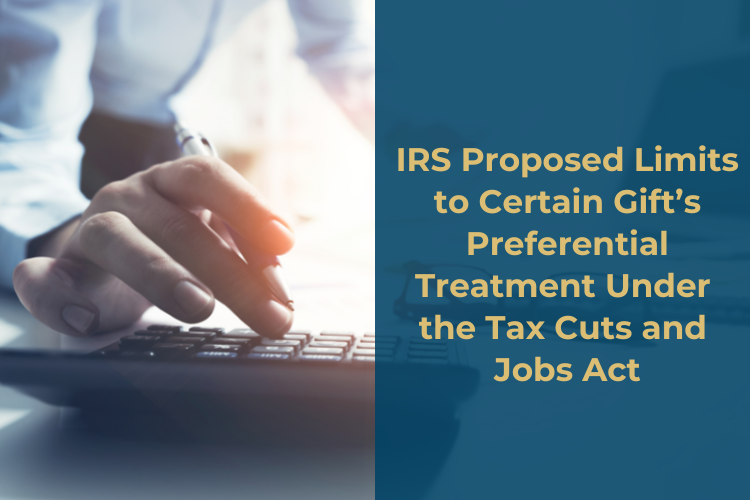IRS Proposed Limits to Certain Gift’s Preferential Treatment Under the Tax Cuts and Jobs Act

written by Arturo Meza, Foreign Associate at CK Tax Services LLC
Background
The US federal government levies three types of taxes on transfers of wealth: an estate tax on the value of assets transferred to other individuals when a person dies; a gift tax on the value of gifts that a person gives to others during that person’s lifetime; and a generation-skipping transfer tax on transfers of wealth to certain recipients.
There are two main exemptions/exclusions from the gift and/or estate tax: the annual exclusion from gift tax and the unified lifetime exemption that applies to gift and estate tax collectively, also known as the basic exclusion amount (BEA).
Currently, the federal government allows individuals to gift up to $16,000 per year per recipient without being subject to the gift tax. If the gift exceeds the $16,000 threshold, donors can exclude the balance from the gift tax through their lifetime exemption, but they must file a gift tax return, Form 709, to report the gift and use of the lifetime exemption to the IRS.
The Temporary Effect of the Increased Exclusion Amount
From 2004 to 2016, the federal estate and gift tax lifetime exemption increased in various amounts from $1 million to $5 million. However, in 2017, as part of the Tax Cuts and Jobs Act, the government temporarily increased the BEA from $5 million per person to $10 million (currently $12.06 million for 2022 as adjusted annually for inflation) in effect from 2018 to 2025. Beginning January 1, 2026, the BEA reverts back to $5 million, which will be adjusted for inflation, and this will remain the BEA unless there is another legislative change.
In 2019, the IRS issued final regulations to address the temporary effect of the BEA, creating a “special rule” to prevent a claw back and let a decedent calculate an estate tax credit in the year of the gift or apply the exemption available at death, essentially allowing individuals to make full use of the $12.06 million gift tax exemption currently, without negative tax consequences if the individual’s death occurs after 2025.
However, the 2019 final regulations did not conclude how completed gifts that are includible in the decedent’s gross estate should be treated. In other words, for estate tax purposes, there are certain gifts that are completed at the time of the transfer but may be included in the donor’s estate if the donor retains certain rights or control over the gifted property.
Regulations Imposing Limitation on the 2019 Special Rule
On April 26, 2022, the IRS proposed regulations addressing the specific issue when the donor retains rights or control over the gifted property that are includible in their taxable estate at death. According to the proposed regulation, these types of gifts do not qualify for the preferential treatment provided for in the 2019 regulations. That is, if the gift is includible in the donor’s taxable estate, the lower BEA applicable at the time of death will be determinative and not the enhanced BEA applicable at the time the gift was made.
Specifically, the 2022 proposed regulations by the IRS limit the application of the special rule on gifts subject to a retained life estate or subject to other powers or interests as described in §2035 through §2038 and §2042 of the Internal Revenue Code; gifts made by enforceable promise, to the extent they remain unsatisfied as of the date of death; transfers of certain applicable retained interests in corporations or partnerships as provided in §2701 or trusts as describe in §2702; and transfers that would have been described in the preceding situations but for the transfer, relinquishment, or elimination of an interest, power, or property, effectuated within 18 months of the date of the decedent’s death, by the decedent in conjunction with any other person, or by any other person. The special rule will continue to apply to transfers includible in the decedent’s gross estate where the taxable amount is 5% or less of the total amount of the transfer, valued as of the date of the transfer.
Comments on the proposed regulations must be submitted to the IRS by July 26, 2022, and if the proposed regulations are ultimately enacted, their implications will be seen as soon as January 1, 2026.
Arturo Meza is a Foreign Associate at CK Tax Services LLC. He is a Mexican licensed attorney with more than 10 years of experience and extensive practice in cross-border transactions between Mexico and the United States.
« Tax Court Rules Foreign Tax Credit Cannot Offset NIIT EU Looks for a Symmetric Exchange of Information Under US FATCA »